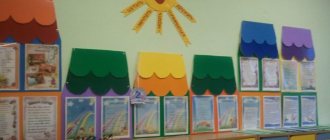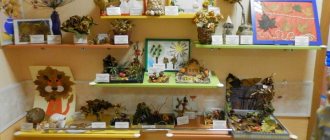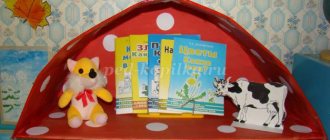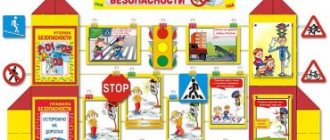Consultations for parents
The consultations for parents section contains advice, rules for parents of preschoolers. Very helpful and well presented. The importance of family leisure as a means of promoting children's health. Caring for children, their well-being, happiness and health has always been and will be the main concern of the family.
Forming character and developing useful skills and abilities are the most important tasks facing parents. The foundation of health, physical and mental, is laid in childhood. Whether this foundation will be strong enough depends entirely on you, parents, on how you raise your children, what useful habits they will acquire. The section presents topics of consultations with parents of young children.
The consultation section of the site, advice for parents of preschoolers for different groups, contains many interesting publications on raising children on various topics:
- Consultation for parents of preschool children
- Consultation for parents of preschool children with disabilities
- The role of toys in a child's life
- How to teach a preschooler to read?
- Preschool children's passion for computer games
- The role of the family in the moral education of children
- Consultation for parents of preschool children “Children’s safety on city streets”
- Preschooler's birthday
- Child's readiness for school. Tips for parents
- The age of stubbornness or the crisis of three years
- Consultation for parents on the topic “Stuttering”
- Children's lies
- What if a child is painfully attached to his mother?
- How is the maturity of a preschooler determined?
- Consultation for parents of preschoolers on the topic “Observations on a walk in autumn”
- The role of play in developing a child’s personality
- Punishing children: benefit or harm?
- What and how to read to preschool children?
- About the role of the father in raising children
- Consultation for parents of preschoolers “Beware of the flu!”
- Introducing preschool children to art
- How to develop children's imagination?
- How to teach a child to work?
- Consultation for parents of preschoolers “Play outdoor games at home with your child”
- How to explain to a child what time is?
- Consultation for parents of preschool children “Theater and Children”
- Kindness must be taught from childhood
- Consultation for parents of preschoolers “Teaching poetry with your child”
- Is it possible to force a child to obey?
- Why do children bite?
- What can a baby do in the first year of life?
- Consultation for parents of preschool children “Father as a teacher”
- Preparing a child to master writing
- Music in a child's life
- Exercises to develop auditory attention in children
- Memory development in preschool children
- 10 Commandments to Parents
- Where do children's fears come from and how to deal with them?
- How to foster a love of reading in a child?
- How should you raise your child?
- Development of fine motor skills. Coordination of movements in combination with speech
- Development of mathematical abilities in preschoolers
- Age characteristics of children of the older group 5-6 years old
- How to make children's vacation comfortable and useful?
Consultation for parents of preschool children is one of the most effective forms of work used in preschool educational institutions. The topic of such consultations should necessarily be a discussion of the child’s adaptation to the conditions of kindergarten. This is a very important problem; the success of the child’s development and education depends on the effectiveness of its solution. Therefore, you need to carefully prepare for this event.
The largest selection of consultations for parents of preschoolers of junior, middle and senior groups. All consultations are free and available for download from the website. Consultations for parents are one of the forms of work of employees of educational institutions with parents of preschool children. Author's consultations for parents involve a convenient and understandable presentation of the material.
LiveInternetLiveInternet
parents Tell your child: 1. I love you. 2. I love you no matter what. 3. I love you even when you are angry with me. 4. I love you even when I'm mad at you. 5. I love you even when you are far from me. My love is always with you. 6. If I could choose any child on Earth, I would still choose you. 7. I love you to the moon, around the stars and back. 8. Thank you. 9. I liked playing with you today. 10. My favorite memory of the day was when you and I did something together. Tell: 11. The story of their birth or adoption. 12. About how you were *affectionate* with them when they were little. 13. The story of how you chose their names. 14 About myself at their age. 15. About how their grandparents met. 16. What are your favorite colors? 17. That sometimes it’s difficult for you too. 18. That when you hold their hand and squeeze it 3 times, it’s a secret code that means *love you*. 19. What is your plan. 20. What are you doing now? Listen: 21. Your child is in the car. 22. What does your child say about his toys, and think about how important this is to him. 23. A question in which your child really needs your help. 24. One second longer than your patience allows. 25. The feelings behind your child's words. Ask: 26. Why do you think this happened? 27. What do you think will happen if…..? 28. How do we find out? 29. What are you thinking about? 30. What is your most pleasant memory of the day? 31. What do you think “it” tastes like? Show: 32. How to do something, instead of prohibiting doing it. 33. How to whistle into blades of grass. 34. How to shuffle cards, make a fan/house. 35. How to cut food. 36. How to fold laundry. 37. How to look for information when you don't know the answer. 38. Attachment to your spouse. 38. That taking care of yourself, taking care of yourself is very important. Take time to: 39. Observe construction sites. 40. To look at birds. 41. Have your child help you cook. 42. Go to some places together. 43. Digging in the dirt together. 44. To complete tasks at your child's pace. 45. Just to sit with your child while he plays. Make your child happy: 46. Surprise and clean his room. 47. Put chocolate in pancakes. 48. Post a meal or snack in the shape of a smiley face. 49. Make some sound effects when you help them do something. 50. Play with them on the floor. Let go: 51. Guilt. 52. Your thoughts about how it should have been. 53. Your need to be right. Give: 54. Look at your child with kind eyes. 55. Smile when your child enters the room. 56. Reciprocate when your child touches you. 57. Make contact before you say (correct) anything so that your child actually hears you. 58. Give your child the opportunity to cope with his dissatisfaction (anger, rage) before helping him. 59. Take a bath at the end of a long day. 60. Choose your favorite way to be kind to your child.
What should parents pay attention to?
For the full development of an older preschooler, it is necessary:
- Respect your child's imagination and support his desire to express himself.
- Be attentive to his desires, being able to stop harmful ones in time.
- Encourage his desire to communicate with peers, as well as ensure meetings with loved ones and family.
- Encourage the child's independence by reducing control and guardianship.
- Answer your child’s questions, even if some of them are “inconvenient.”
- Help to overcome fears, listen to the child, support him.
Anime pictures for stands
Preschool educational institutions must have themed corners that help children learn, gain important life skills, simply play, have fun and bring their creative potential to life. To design such corners, educators need visual aids and all kinds of pictures. To make the corner special and unique, you can complement it with anime pictures on different topics.
Leisure in kindergarten and holidays
Traffic regulations, fire safety and health protection
Seasons:
Pictures for a safety stand: safety corner in kindergarten design
A corner with visual materials on the topic of safety is an integral part of the overall design of each group in kindergarten. By studying useful pictures, instructive stories, tips and rules, young explorers learn to recognize danger both at home and on the street.
Proper design of the safety stand in the future will certainly protect many children from injury, and perhaps even save their lives.
To make it easy to create a stand with information interesting for kids, you can use ready-made pictures and useful materials for filling.
safety rules for children in pictures
Templates for stands and posters about safety for children:
safety pictures for children in kindergarten
Information in the “Your Safety” section of the stand:
summer safety pictures
safety at home and on the streets
promoting safety in preschoolers
about fire safety for children
pictures of rules of behavior for children
what to do if you get lost on the street
Pictures for stands for parents
On the walls of the corridors of kindergartens you can often find stands with educational information for parents. They are designed to teach parents important rules for the safety of their children, interesting aspects of raising and developing a child, as well as to promote a healthy lifestyle. Information stands can be supplemented with sections that will be taught by educators, a speech therapist, and a full-time psychologist.
stand templates for parents
memo to parents pictures
Pictures for sections on child safety
pictures of the alphabet of health
pictures of psychologist's advice
pictures of advice to parents
pictures of speech therapist for children
“Information stands in preschool educational institutions for parents”
Brief description of the document:
1slide.
Dear colleagues, I would like to present to your attention a presentation on the topic: Information stands in preschool educational institutions for parents.
2 slide.
An important element of modern preschool education and upbringing is versatile work with the families of pupils.
Education is inextricably linked with the psychological and pedagogical education of parents; it is they who lay the foundations of the child’s character and form the characteristics of his relationships with peers and adults.
One of the effective tools for pedagogical influence in a preschool institution is a colorful information stand. With its help, the teacher guides parents to knowledge and understanding of pedagogical principles, and also provides a variety of useful information about the features of the development and upbringing of preschool children.
3 slide.
There are two types of stands: Thematic, which can be designed for children, and informational, where information for parents is located.
Information stands should always be the center of attention! They are distinguished by their unusual shape, colorfulness, convenience and versatility in use.
4 slide.
Places for placing the stand should be frequently visited by parents of preschool children (near the head's office, first-aid post, educational psychologist and speech-language pathologist, group locker room, etc.).
A traditional information stand should be colorful and bright, attracting attention, and designed according to a single plot: a fairy tale or theme (space, healthy lifestyle, daily routine, etc.).
Text materials can be placed in special pockets made of plexiglass or transparent plastic.
The text of the stand must be printed or written in large font on a light background so that it can be read at a distance of 2 - 3 meters. The information should be supplemented with bright pictures (stickers). The topic is highlighted in a different color or in a larger font.
A comfortable perception of the information stand is ensured by using a color combination with the interior of the preschool institution (preferably calm, neutral tones).
The topic of the information stand must be relevant and interesting, presented in an original way.
The content of the stand should be specific, concise, accessible, aesthetically pleasing and safe, and updated regularly (at least once a month). It is important to avoid special terminology in the text and replace it with simple concepts.
An important condition when placing a stand is the strength and safety of the structure. All information material must be firmly attached to a wooden or plastic base. It is not advisable to stick sheets of paper to the wall and use pins and paper clips.
5 slide.
Educating a child in preschool age is a joint process for which both the preschool educational institution and the parent are responsible. Thus, the entire process must be monitored and discussed. The following information may be present in the locker room:
6 slide.
Medical education and prevention of childhood infectious and viral diseases (tips and recommendations, anthropometric data of children, diet, etc.);
Slide 7
Information on regime moments and training schedule
8 slide.
children's creativity corner , it displays children's work in drawing, appliqué, modeling, design, and also houses personal exhibitions of children's productive creative activities at home and in kindergarten.
Slide 9
Preschool menu
Thank you... Congratulations... (Words of gratitude to parents for their help, etc.);
10 slide.
You can easily make stands for decorating a locker room in a kindergarten yourself. It is enough to buy thin plastic, film and print the letters on any printer. You can use scissors to cut out the general shape of the stand of the required dimensions from plastic. Then cover it with film. Make pockets from the film in which to place sheets of information. With this method you will significantly save on the design of the locker room. Such stands were made in my group.
11 slide
Thank you for your attention!
Speech and imagination
Improving speech affects, first of all, its sound component - the reproduction of sounds (hissing/whistling/sonorous) improves.
Developing:
- Grammatical structure.
- Coherence of speech.
- Phonemic hearing.
- Intonation expressiveness.
- Emotional component.
Reading poetry becomes more expressive - attention is focused on the semantic component of the text, vocabulary is enriched through the use of synonyms/antonyms. Active word creation is noted - preschoolers can easily compose a retelling or story from a picture, while attention is also paid to details.






